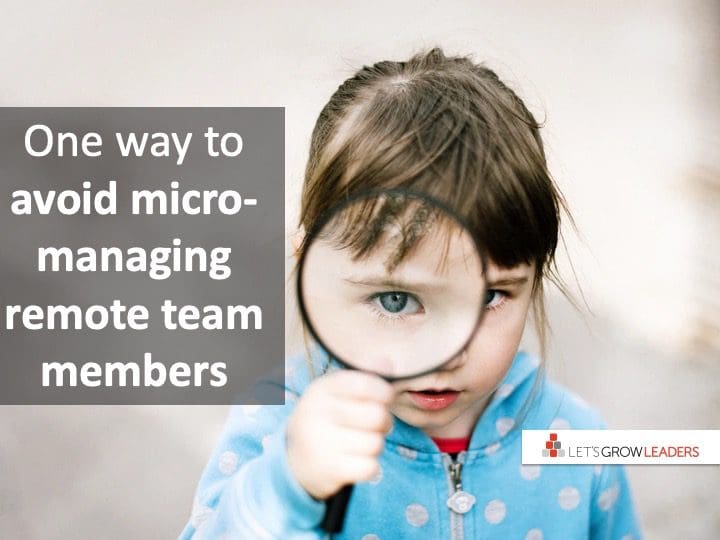Avoid micro-managing virtual team members by scheduling a clear finish.
Recently we spoke with Shawna, an executive who reflected on the past year and the shift to remote work. “We’ve exceeded our goals, but I also am sure that our failure to follow through on some things has cost us between twenty and thirty million dollars. I’m worried about micro-managing virtual team members, but also want to make sure we’re following through.”
Increasing numbers of organizations have committed to long-term remote work.
At the same time, the initial burst of pandemic-response energy and creativity is giving way to the realization of the many challenges that aren’t going away any time soon: family members will still be in the background as employees try to balance working from home and homing from work; that remote team productivity and collaboration take serious work; and, that broad economic turmoil turns up the heat on the need to stay competitive in the marketplace.
How can leaders ensure that their teams achieve the results necessary to keep the business moving while creating space for the realities of working from home – and all without micro-managing virtual team members?
Schedule the Finish
Good intentions and talented people aren’t enough to make sure the most important priorities happen.
Especially when your people have a thousand things hitting their windshield plus the challenges posed by working from home, pandemic stress, the movement for racial equity, economic instability, and worrying about how they’ll manage another semester with their children attending school from home.
Life is crazy and your team has more to do than time to do it. Their interruptions will get interrupted. If you don’t have an intentional, focused way to finish what you start, it won’t happen.
Effective leaders don’t leave the finish to chance or a heroic act of willpower. (Most of us have used up the heroic willpower reserves by this point.)
That’s where “scheduling the finish” comes in. Scheduling the finish means you and your team don’t leave the completion of critical items to chance, good intentions, or willpower.
Rather, you schedule a mutual moment in time where you will follow up, follow-through, and finish the task. This isn’t a vague intention – it’s an appointment on the calendars of everyone involved.
Avoid Micro-managing Virtual Team Members
Scheduling the finish helps you avoid constant check-ins and follow-ups for task completion.
You do want to stay connected with your remote team members. But connection takes many forms—personal interest, emotional thoughtfulness, and fun – and business transactions.
Knowing that there is a moment in time where you will turn on the camera and discuss the completed priority allows you to focus on other vital forms of connecting with your remote team members.
Make It Automatic
If you have to spend energy trying to remember everything you and all your virtual team members need to finish you’ll never do it. There’s just too much going on and your brain has limited energy. Just thinking about every open loop can be exhausting.
Here’s how it works.
The moment you set an intention, make an appointment with yourself or with the other person where you will complete the intention or take the next step. The key is when. What moment in time will you follow up, follow-through, and finish?
Here are some examples:
- When you have a performance conversation using the INSPIRE model, the final step (E) is the Enforce step. Schedule a brief meeting to review their desired behavior. Eg: “Sounds good. Let’s meet at 10 next Tuesday to see how this is going and if you have any questions.”
- As you delegate, schedule a time where the other person will meet with you in person or by video to return the project to you, answer questions, and discuss next steps.
- When you lead a meeting, conclude the meeting by asking who will do what, by when, and “How will we know?” The final “How will we know?” are scheduled commitments to the team. Eg: “We will all have our data to Linda by Friday at 4 pm. Linda will send us the new process by Wednesday at 3 pm.” Everyone puts the times on their calendar. If Friday 4 pm comes and Linda doesn’t have data from Bob, she calls him. If 3 pm Wednesday comes and they don’t have the process, they call Linda.
Make an Appointment
The key in all these examples is to make an appointment. There is a difference between a to-do item and scheduled time on your calendar, particularly when that time is scheduled with another person. The likelihood of you both keeping your commitment increases significantly.
For items that don’t naturally fit in a calendar appointment (eg: you’re rolling out a new process to improve on-time delivery and quality), you can still make appointments with yourself to reinforce the initiative (communicate at least five times through five different channels) and to review performance.
When you create an expectation – particularly a new one that is the result of training or a new process – follow through on behavior quickly. And, when people get the behavior right, celebrate it, acknowledge it, and reinforce that this is what people like us do.
When it doesn’t happen, have quick INSPIRE conversations to redirect people back to the new way of doing things. If there are problems that prevent people from doing what’s needed, solve them quickly and visibly.
Your Turn
We often see energetic, type-A leaders who excel at inspiring vision, creating a process for success, and setting goals, struggle with follow-through. It doesn’t feel as fun as creating or motivating.
That’s why we invite you to make it an inseparable part of getting started. When you make a goal, start a project, or introduce a process, don’t stop until you’ve scheduled the finish. You’ll leverage your team’s energy, focus, and boost morale when everyone feels good about what they’ve achieved.
See Also: How to Hold an Effective Mid-Year Review in a Pandemic







0 Comments